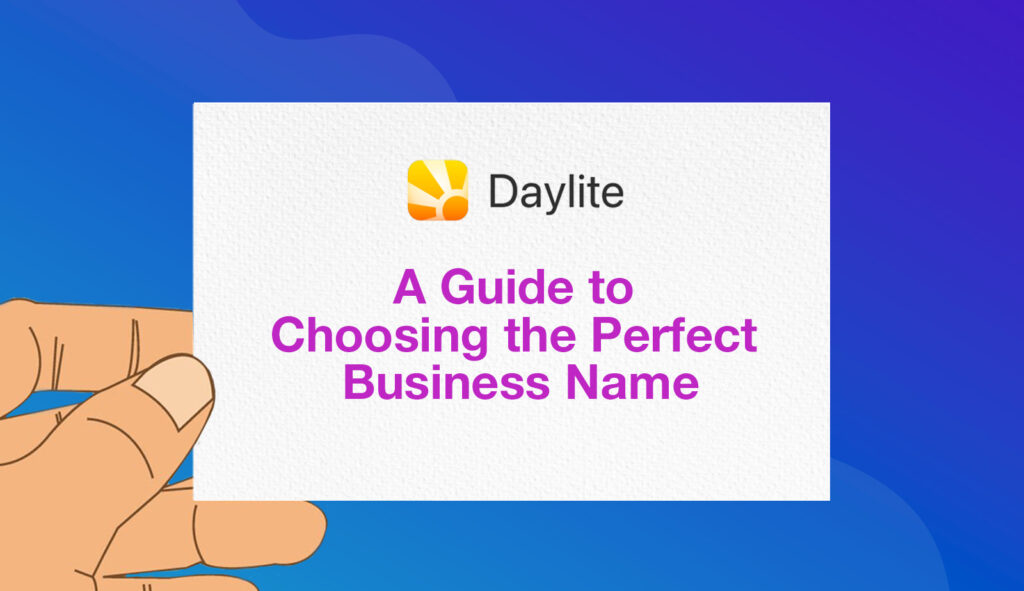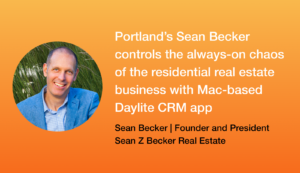Choosing the right name for your business is not just about selecting words; it’s about crafting an identity that resonates with your audience, captures the essence of your brand, and leaves a lasting impression in the minds of your clients.
Your business name is the cornerstone of your brand identity – it’s the first thing people will associate with your services, and it sets the tone for the entire customer experience.
In this guide, we’ll walk you through the essential steps to follow to name your business, empowering you to create a name that not only aligns with your vision and values but also meets all legal requirements and sets you up for success.
Whether you’re a budding entrepreneur or a seasoned business owner embarking on a rebranding journey, this guide will provide you with the knowledge and tools you need to create a business name that stands out, resonates with your target audience, and helps you achieve your business goals.

Summary:
- Understanding Your Brand Identity
- Brainstorming Techniques
- Consider SEO (Search Engine Optimization)
- Ask for Feedback
- Navigating Name Regulations and Restrictions
- Steps to Formalizing Your Business Name
1. Understanding Your Brand Identity
Before diving into the intricate process of naming your business, it’s crucial to embark on a journey of self-discovery. Start by defining your business values and mission – these are the guiding principles that will shape every aspect of your business, including your name.
Think about:
- What do you stand for?
- What drives you?
- What sets you apart from the competition?
By understanding your brand’s core values and mission, you’ll be better equipped to choose a name that truly reflects who you are and what you aspire to achieve.
It’s also crucial to research your competitors and market trends. Take a close look at businesses similar to yours – what are their names? Are there any naming conventions or trends that you can leverage or avoid? By conducting thorough market research, you can identify gaps in the market and opportunities to differentiate your business. Your goal is to stand out in a crowded marketplace, and understanding your competitors and market trends is key to achieving that goal.
2. Brainstorming Techniques
When it comes to brainstorming techniques for naming your business, there’s no shortage of creative approaches to explore. Here are a few techniques used and implemented by some of the leading companies in different industries:
- Word association exercises: Grab paper and pen and start jotting down words or phrases related to your services, industry, or target audience. Be spontaneous and try to think outside the box. As you brainstorm, observe patterns or recurring themes emerging among the words you write. Then, analyze these associations to discern potential name ideas that encapsulate the essence of your business. This can help you explore different angles and concepts as you may stumble upon unexpected and unique combinations that resonate with your brand identity. If you need extra help, try this word association exercise.
- Outdoor apparel company “Patagonia” utilized word association to capture the essence of adventure and exploration. Founders Yvon Chouinard and Tom Frost wanted a name that reflected the rugged beauty of the Patagonian region, known for its untamed wilderness and challenging terrain.
- Mind mapping: Start by selecting a central idea or keyword pertinent to your business, then expand upon it by branching out with related words, concepts, and associations. Explore connections between various elements and themes, continually expanding and refining your mind map as new ideas surface. Utilize the mind map as a tool to identify potential name concepts and themes that resonate with your brand identity.
- Ride-sharing giant “Uber” used mind mapping to conceptualize its name. The founders, Garrett Camp and Travis Kalanick, wanted a name that conveyed the idea of being “super” accessible and convenient. Through mind mapping, they explored various synonyms and related concepts before settling on “Uber,” which means “super” in German.
- Online Tools and Resources: Use online tools such as name generators, domain availability checkers, and brand name databases to generate and evaluate potential names for your business. Leverage keywords or concepts related to your business to generate a list of name ideas, and assess their relevance, availability, and brandability. Finally, compile a list of promising names to further refine and explore as you narrow down your options.
- Skincare brand Glossier founder Emily Weiss wanted a name that captured the essence of dewy, radiant skin and a fresh-faced aesthetic. By leveraging online tools like name generators and domain availability checkers, she explored various possibilities before landing on “Glossier.”
- Leverage your personal experience: Reflect on your personal background, interests, and experiences to draw inspiration for your business name. Identify any unique aspects of your journey or expertise that could serve as a foundation for your brand identity. Consider names or themes that resonate with your personal story or values, drawing inspiration from memorable moments or significant milestones in your life.
- The name “Levain” was inspired by the founders’ shared passion for baking. “Levain” refers to the natural leavening agent used in sourdough bread, highlighting the bakery’s commitment to quality ingredients. By drawing on their personal experiences and culinary expertise, the founders created a name that conveys authenticity and craftsmanship.
These brainstorming techniques help you create compelling and memorable names that resonate with your target audience. Whether through word association, mind mapping, online tools, or personal experiences, the key is to explore different avenues and think creatively to find a name that truly reflects your brand identity.
Consider SEO (Search Engine Optimization)
When choosing a name for your business, it’s not just about sounding cool or catchy. It’s also about making sure people can easily find you online. That’s where SEO comes in.
SEO stands for Search Engine Optimization, which basically means making your business rank higher in Google searches. So, when you’re choosing a brand name, think about including words that people might search for when looking for your service.
For example, in the tech industry, many people search for terms like “tech,” “genius,” and “hub” when looking for services or communities related to technology. By combining these keywords into one brand name, “TechGeniusHub,” you can signal to search engines and potential clients that you offer tech-related solutions or services and work as a hub for tech enthusiasts.
Now, you might ask: “How do I find these commonly searched words for my industry?”
The answer is: keyword research!
When choosing your business name, it’s essential to conduct a keyword research to identify relevant terms and phrases that your target audience is searching for.
Researching keywords is easier than it sounds. Here’s a step-by-step:
- Use the words you jotted down during the brainstorm phase and use tools like Google Keyword Planner or SEMrush to find related words that might have slipped your mind.
- Check the search volume of each of the keywords in your list. The higher the search volume, the more people are using that word in their web searches. Check out this begginers guide for extra help checking the search volume of your keywords.
- Assess competition. High volume keywords have the higher traffic, which might make it harder for you to rank high in the search. Consider mixing high and medium-traffic keywords with moderate competition but that are still relevant to your industry.
By considering SEO when selecting your brand name, you can set your business up for greater online visibility and success in the competitive digital landscape.
Ask for Feedback
When naming your business, it’s a good practice to seek feedback from colleagues, peers, friends, and family. Leverage their insights to evaluate the clarity, memorability, and cultural implications of your name ideas. In addition, if you have the means to do so, take advantage of surveys, polls, and direct engagement with potential clients to gauge public opinion and emotional resonance. By listening attentively to your audience’s feedback and preferences, you can refine your name to ensure it captures attention and fosters a deep connection, ultimately leading to a name that stands the test of time and resonates powerfully with your target market.
Navigating Name Regulations and Restrictions
Amidst the excitement of naming your business, it’s essential to tread carefully through the labyrinth of regulations and restrictions of the naming process.
At the same time that you should make sure your business name is catchy and memorable, you also need to ensure it doesn’t infringe trademark regulations or mislead clients. Here are a few common naming rules to make sure your business name is legal and up to the norm:
- Avoid using misleading or deceptive names that may confuse consumers.
- Ensure your business name does not infringe on existing trademarks or violate intellectual property rights.
- Some states or provinces have specific naming rules, such as prohibiting certain words (like “bank” or “insurance”) unless your business is licensed in that industry.
- Your business name should not include prohibited words or symbols, such as obscenities or trademarks of other companies.
Steps to Formalizing Your Business Name
As you lay the groundwork for your small business, one crucial step stands between vision and reality: registering your business name. This process not only formalizes your presence in the marketplace but also establishes legal clarity and protection for your brand name.
To make this process easier for you, here’s the step-by-step process of registering your business name and making it official, ensuring compliance with legal requirements while navigating the intricacies of naming regulations and restrictions.
Keep in mind that this is just a general guide and that regulations may vary according to your country, province or state. Make sure to contact a lawyer for further guidance in this process.
Step 1: Check Availability
- Once you have a name for your business, you must ensure it’s not already in use by another business. Conduct a thorough search in online databases such as your state or province’s business bureau website or patent and trademark office database, to see if the name is already registered or trademarked.
Step 2: Register Your Business Name
- Register your business name with the appropriate government agency. The process varies depending on your business structure and location:
Step 3: Obtain the Necessary Permits and Licenses
- Depending on your business type and location, you may need to obtain additional permits or licenses to operate legally. Check with your local government or small business administration for specific requirements.
Step 4: Consider Trademark Protection
- While registering your business name provides some legal protection, consider trademarking your name for added security. A trademark prevents others from using your business name or logo without permission.
By following these steps and adhering to naming regulations, you can register your business name and make it official, establishing a solid foundation for your small business venture. Remember to consult with legal and regulatory experts if you have any doubts or questions during the process.
Wrapping Up
Choosing the right name for your small business is more than just a creative endeavor – it’s a strategic decision that can shape your brand’s identity and impact its success. Throughout this journey, we’ve explored the key considerations and best practices for selecting a business name that resonates with your audience, reflects your values, and complies with legal requirements. From brainstorming creative ideas to conducting thorough research and seeking feedback from trusted advisors, every step plays a crucial role in crafting a name that stands out in a competitive landscape.
As you embark on this exciting journey of entrepreneurship, remember that your business name is more than just a label – it’s the embodiment of your vision, passion, and commitment to excellence. Whether you’re launching a new venture or rebranding an existing one, we’re here to support you every step of the way.
We hope this article has given you the necessary tools to choose the perfect name for your business. If you found these insights valuable, we encourage you to share this article with your small business community and lend a helping hand to others embarking on their entrepreneurial journeys. Together, we can support and uplift one another in achieving our business goals.
Discover Daylite – The Ultimate Small Business Tool for Mac, iPhone and iPad
Discover the power of Daylite today with our free 14-day trial. Experience how Daylite seamlessly combines CRM, Sales, and Project Tracking to help you streamline your small business management on Mac, iPhone and iPad. Start your free trial now and embrace the efficiency and organization you’ve been longing for.
Want to stay connected and get the latest updates from Daylite?
Follow us on Facebook, Twitter, LinkedIn or Instagram, and subscribe to our newsletter.
Join our thriving community of Mac users and small business owners to access exclusive content, helpful tips, and valuable insights. Get started today and transform the way you manage your small business with Daylite for Mac.
About the author: Thanny Schmitz is a seasoned copywriter and content strategist passionate about technology and entrepreneurship. With over a decade of experience, Thanny has been behind insightful articles and blogs that inform and spark meaningful conversations within the ever-evolving spheres of tech and small business success.


